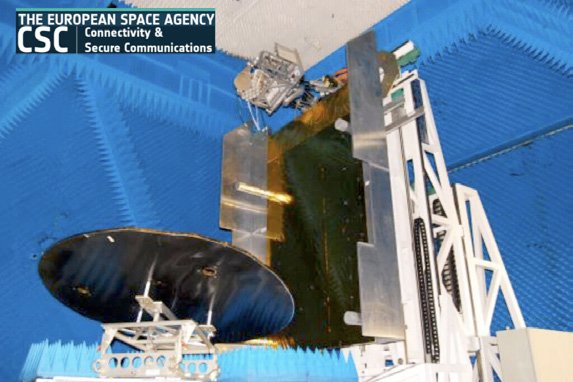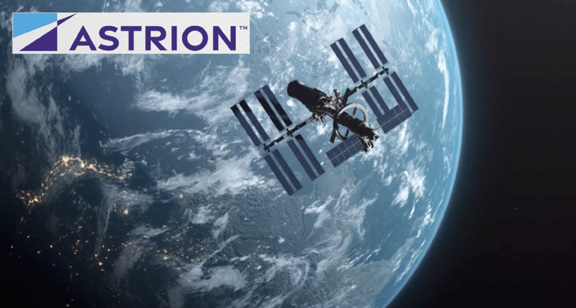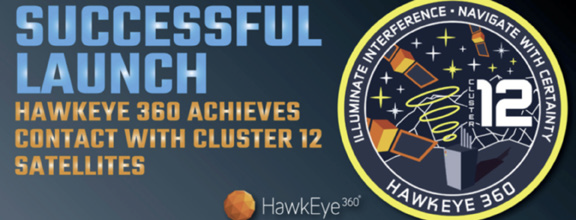Curtiss -Wright Awarded $31 Million IDI Q Contract by the U.S. Navy to Supply Airborne Miss ion Process ors for the Triton UAV
Curtiss-Wright Corporation will provide Airborne Mission Processors (AMP) and AMP spare parts in support of PMA-262 Persistent Maritime Unmanned Aircraft Systems’ MQ-4C Triton aircraft and PMA-290 Maritime Patrol and Reconnaissance Aircraft under a $31 million firm-fixed-price indefinite delivery, indefinite quantity (IDIQ) contract awarded by the Naval Surface Warfare Center (NSWC).

The contract also includes Total Lifecycle Management™, training, and engineering services in support of the AMP. Work on the contract will be performed by Curtiss-Wright’s Defense Solutions Division and is scheduled to run through September of 2029.
The AMP features Curtiss-Wright’s industry-leading MOSA modules, including the VPX6-1959 single board computer, CHAMP-XD2M High Memory Capacity Multi-Core HPEC Module, VPX6-684 Network Switch, and VPX6-4943 GPGPU board, as well as the front panels, fan control board, and chassis.
Curtiss-Wright previously announced that it is providing and servicing MOSA- based Keyed Broad Area Maritime Surveillance Airborne Recorder (K-BAR) Network Attached Storage (NAS) solutions supporting MQ-4C Triton and future PMA-290 aircraft, including chassis, docking stations, removable storage modules and lab cable sets.
“We are very proud to have been selected by the Naval Surface Warfare Center to provide our rugged airborne mission processor technology, total lifecycle management and support services for Naval manned and unmanned aircraft programs,” said Brian Perry, Senior Vice President and General Manager, Curtiss-Wright Defense Solutions Division. “The AMP system was derived from the legacy Airborne Mission Management System previously qualified and deployed on the Triton UAV platform. Through only minor enhancements, Curtiss-Wright was able to significantly increase processing capability in the aircraft, enabling enhanced ISR features, and the ability to host Navy Minotaur software platforms.”
ESA teams with Leonardo against satnav jamming
Uninterrupted access to satellite navigation is essential in our modern world, but it is threatened daily by external interference, such as jamming and spoofing.

New technologies and concepts can help increase the resilience of our satellite navigation solutions. ESA and Leonardo recently embarked on a joint project to explore smart antennas powered by Machine Learning (ML) to block unwanted signals.
Through its different Navigation programs, ESA is actively exploring innovative technologies to increase resilience of Global Navigation Satellite Systems (GNSS systems). ESA and Leonardo (IT) have signed a contract to research and develop ML techniques to steer antenna arrays to block out unwanted signals. The project will be developed under the umbrella of ESA’s Navigation Innovation Support Program (NAVISP).
Conventional antennas catch signals from all directions. A Controlled Reception Pattern Antennas (CRPAs) antenna can focus on signals coming from specific satellites and ignore signals or interference coming from other directions. These types of antennas are used in satellite navigation receivers to block jamming and counterfeit signals. They rely on electronics that control how they adjust their patterns (a concept known as “beamforming”).
Under contract with NAVISP, Leonardo together with ELT Group as subcontractor, will explore the reduction of the distance between the antenna elements to reduce the size and weight of the antenna array, and the use of Machine Learning to determine the best antenna setup and adjust the settings faster. This approach will lead to smaller, smarter and more effective antennas, especially useful in space-limited environments such as aircraft.
The project covers identification of the smarter algorithm for signal blocking, building and testing a real-time receiver demonstrator based on the selected algorithm, and comparing it to conventional larger antennas. The aim is to reach a Technology Readiness Level (TRL) of 4, delivering a lab-tested technology by the end of the project, in two years.
ESA navigation specialists are supporting cutting-edge European companies in the development of new PNT technologies and services – in support of Europe’s industrial competitiveness, autonomy and leadership. The result is ESA’s Navigation Innovation and Support Programme, NAVISP. NAVISP is looking into all kinds of clever ideas about the future of satellite navigation and positioning, navigation and timing: ways to improve satellite navigation, alternative positioning systems and new navigation services and applications.
Astrion’s Axient among other firms selected for USSF STEP 2.0 contract to accelerate military space innovation
Astrion, through its legacy company Axient LLC, has been selected by the U.S. Space Force (USSF) as one of 12 awardees on the Space Test Experiments (STEP) 2.0 program.

STEP 2.0, a 10-year, multi-award Indefinite Delivery/Indefinite Quantity (IDIQ) contract worth up to $237 million, aims to advance military space technology, reduce costs, and streamline processes by harnessing the latest in commercial innovation.
Astrion and the other contract awardees will bid on task orders to build modular satellites and integrate them with various experimental payloads, enabling USSF to conduct tests on emerging technologies on-orbit.
Astrion has a long history of partnership with USSF Space Systems Command, supporting critical programs including the National Security Space Launch, Missile Warning, Global Positioning, and New Entrant Certification missions.
In addition, for nearly two decades Astrion teammate Orion Space Solutions, an Arcfield Company, has developed trusted space-based solutions for the national security and intelligence communities.
Administered by USSF’s Space Systems Command’s (SSC) Department of Defense (DoD) Space Test Program (STP), STEP 2.0 is expected to issue its first delivery order in January 2026.
Other organizations selected for the STEP 2.0 contract include Blue Canyon Technologies, General Atomics, Lockheed Martin Corp., Loft Orbital Federal, Lynk Global, Orbit Systems, Spire Global Subsidiary, Turion Space Corp., Tyvak Nano-Satellite Systems, Utah State University Space Dynamics Lab, and York Space Systems.
Dan Benjamin, Astrion’s Executive Vice President and General Manager, Space, said, “We look forward to this opportunity to build on our space integration history delivering our extensive experience, bold ideas, and unmatched execution in support of STEP 2.0.”
Maxar + Saab engage in a partnership to develop multi-domain battlespace Solutions
Maxar Intelligence has engaged in a strategic partnership with Saab to jointly develop next-generation multi-domain battlespace solutions, with a specific focus on advanced space-based C5ISR systems (Command, Control, Communications, Computers, Cyber, Intelligence, Surveillance and Reconnaissance) for the digital battlefield and GPS resilience for autonomous drone systems— these solutions will help Europe accelerate the development of more advanced sovereign space-based capabilities.

Through a Teaming Agreement, Saab can access Maxar’s geospatial intelligence and advanced mission products such as Raptor, as well as draw upon the company’s technical expertise. The deal expands on Maxar’s existing relationship with Saab, which has most recently focused on deploying Maxar’s Raptor product for autonomous drone navigation and operation in GPS-denied environments.
The agreement builds on successful joint testing of Maxar’s Raptor software product. The technology was tested with Saab in multiple countries, including a demo in real-world conditions where the product demonstrated the ability to accurately extract ground coordinates within an accuracy of less than 2 m.
Maxar’s geospatial intelligence products will also help Saab build more advanced C5ISR solutions through secure access to the most advanced commercial satellite imagery in near real-time. Maxar’s global 3D terrain data unlocks unique opportunities for real-time multi-source data fusion, enabling truly joint multi-domain operations, seamless interoperability between autonomous systems and enhanced mission coordination.
“This partnership will bring together Maxar’s industry-leading geospatial intelligence products with Saab’s highly advanced defense systems to solve some of the most complex tactical and operational challenges across the battlespace today—from powering more intelligent, real-time multi-domain command and control systems to helping autonomous systems overcome GPS jamming,” said Dan Smoot, Maxar Intelligence CEO. “The deal also reflects the growing realization that geospatial intelligence can go beyond powering analyst workflows to powering mission-focused software products deployed at the tactical edge. And, most importantly, our partnership with Saab underscores Maxar’s deep commitment to supporting our international customers as they continue to build up their sovereign defense capabilities, both in Europe and across the globe.”
“Our collaboration with Maxar represents a significant leap forward in our commitment to use information from the Space domain and thereby enhancing the strategic defense capabilities of Europe and beyond,” said Görgen Johansson, head of Saab’s Dynamics business. “By integrating Maxar’s high-end geospatial insights and satellite capabilities with our advanced defense systems, we are setting new standards in the effectiveness and reliability of military operations across multiple domains.”
Kymeta’s breakthrough multi-band antenna redefines connectivity
In a world-first, Kymeta, recently announced a major technological leap: simultaneously operating across both Ku and Ka satellite bands in a single, compact antenna—laying the technical groundwork to enable seamless connectivity across satellite networks.

This breakthrough marks a significant milestone for the SATCOM industry, ending a legacy of siloed SATCOM limitations. Kymeta has now advanced the ability to interoperate across satellite networks in different bands and different orbits, in a move to make satellite as seamless and ubiquitous as cellular.
The ability to connect to both Ku- and Ka-band beams offers immediate and significant benefits—unlocking higher bandwidth, faster data rates, and more bits per second (bps). This also enables continuous connectivity, a vital component toward making advanced AI at the edge a reality. The breakthrough will now allow manufacturers to build the advanced tech of the future where this is a requirement.
This achievement meets the demands of global militaries. The U.S. Space Force vision whitepaper in 2020 outlined the requirement to support multi-bands, orbits, waveforms and a “network of networks to support responsive and agile operations.”
Along with traditional C2 (Command and Control) functions, autonomous applications such as unmanned surface and aerial vehicles (USV, UAV and UGVs) require strong, reliable connectivity to operate and be competitive on the battlefield. This serves as a network hub and backhaul for downstream communication using MANET, mesh and cellular networks that will enable autonomous system operations at scale.
Relying on a single network connection is insufficient to meet the complex and evolving needs of modern global forces, making multi-band beam switching a strategic necessity. This capability allows for simultaneous and redundant communication links, which are critical for maintaining operational integrity in contested or jamming-prone environments while on the move.
The technology was successfully demonstrated and validated at Kymeta on April 22, 2025. This achievement was made possible by Kymeta’s unique metamaterials antenna surface.
Until this point, interoperability in the Ku and Ka bands has been possible only with Electronic Steered Antennas (ESA) using multiple physically separate antennas, which proves problematic due to the size and power usage required to operate. This technological disruption by Kymeta allows connectivity in both bands in one single antenna, giving space efficiency, low power consumption, and low cost (SWaP-C).
The physical area of Kymeta’s multi-band antenna aperture consisting of four, interleaved sub-arrays—Ku transmit, Ku receive, Ka transmit and Ka receive—allows for simultaneous and independently controlled Ku and Ka full duplex beams from its metamaterials surface. Structuring the antenna in this way, and pairing it with advanced AI algorithms for intelligent routing, enables frequency reuse and alleviates spectrum contention via Kymeta’s narrower receive and transmit beams. These beams are more focused and operate at higher directivity, promoting spectrum efficiency and interference mitigation, such as GEO / LEO beam straying, jamming and adverse weather like rain fade and atmospheric losses.
Bruno Fromont, Intelsat CTO, said, “Transformative technology milestones like this spark a catalytic shift across an entire landscape. Kymeta’s ability to unify Ku- and Ka- band connections through a single mobile antenna is a foundational leap toward combined satellite networks, making communication as seamless and automatic as the cellular networks we use every day. This success is changing the game.”
Ian Canning, president and CEO of Eutelsat America Corp + OneWeb Technologies (EACOWT), said, “The U.S. DoD and defense forces around the globe require increasingly sophisticated, flexible and secure communications, which includes the need for high-performance, multi-band, multi-orbit connectivity from a single antenna. Kymeta’s ESA platform, reflecting their continued investment in innovation, is truly disruptive, and brings multi-orbit and multi-band capabilities into the modern era. I look forward to collaborating with Kymeta to develop world class satellite communication products that will open the door to the resilient communications required in the modern battlefield.”
General (ret) Paul J Kern, former Commanding General, Army Materiel Command, currently Senior Counselor, The Cohen Group, said, “Kymeta’s breakthrough in seamless switching between Ku and Ka satellite bands delivers the kind of resilient, always-on communications that advanced military platforms and autonomous systems demand. This is a major step forward in preparing and equipping our forces for the modern battlefield. This capability would have made an enormous difference to my operations in the desert of Iraq.”
Kymeta Chief Scientist, Ryan Stevenson, said, “At Kymeta we’ve never followed convention. What began as novel metamaterials technology is now a proven engineering foundation - first brought to market in 2017, and now central to this groundbreaking achievement. We’ve turned breakthrough physics into a powerful, trusted toolkit. Using this toolkit we have now addressed the most challenging requirement in satellite communications. We have cracked the code on seamless multi-orbit, multi-band connectivity - and have set the standard for next-generation satellite communications.”
NAL Research’s new products use Iridium’s Enhanced SBD ® service for government and Military users
NAL Research, which delivers resilient wireless and APNT solutions, announces the integration of Enhanced Short Burst Data (ESBD), leveraging the next generation version of Iridium’s Short Burst Data® (SBD®) service, into its industry-defining SHOUT trackers. The incorporation of this advanced two-way data transmission solution will bolster secure communications for U.S. Department of Defense, federal, state/local, and approved allied government users.

The Enhanced SBD solution increases transmission security (TRANSEC) through the use of multiple cutting-edge techniques that ensure users can operate safely in all environments.
“This next-generation service provides many advanced capabilities compared to the traditional Short Burst Data (SBD) service,” said NAL Research Director of Connectivity Solutions, Bart Polizotto. “Through ESBD and NAL’s reliable low size, weight, and power (SWaP) solutions, government and military users can benefit from greater warfighter safety, tactical operations velocity, and more secure communications.”
In addition to offering secure, on-demand messaging and data transmission globally, ESBD increases transmission rates and enables larger data payload sizes to support a broad range of missions.
ESBD airtime service is provided by the United States Space Force (USSF) Enhanced Mobile Satellite Service (EMSS) and is backwards compatible with the existing SBD service.
New HawkEye 360 satellite cluster supports miss ion success for government and allied partners in complex environments
HawkEye 360 Inc. has made successful contact with its Cluster 12 satellites following their launch from New Zealand aboard a Rocket Lab Electron rocket— Cluster 12 was launched on June 26 (ET) / June 27 (NZT) and includes three formation-flying satellites designed to detect, characterize, and geolocate radio frequency (RF) signals.

The mission also included Kestrel-0A, an experimental satellite designed to evaluate emerging capabilities and inform future technological advancements.
As the first HawkEye 360 cluster to operate in a dawn/dusk sun-synchronous orbit (SSO), Cluster 12 fills a critical coverage gap in polar orbit revisit and expands the company’s ability to deliver timely RF insights in strategically significant regions.
The cluster continues the proven design of Clusters 9 through 11 and includes a demonstration of a Ka-band downlink to evaluate higher throughput for potential future use.
Cluster 12 further reinforces HawkEye 360’s commitment to advancing space- based RF capabilities in support of global security and situational awareness.
The company continues to deliver multidimensional signals intelligence that equips allied governments and intelligence organizations with critical knowledge for informed, timely decision-making.
“Successful contact with Cluster 12 is the result of meticulous engineering, rigorous testing, and seamless coordination with our launch and mission partners,” said Lorin Metzger, Senior Vice President of Engineering at HawkEye 360. “We’re proud of the team’s work in ensuring a smooth deployment and look forward to bringing this new cluster fully online in the coming weeks.”
“Cluster 12 strengthens our mission to deliver timely, defense-relevant RF insights that empower our government and allied partners operating in complex, dynamic environments,” said Patrick Zeitouni, Chief Strategy Officer at HawkEye 360. “By extending coverage through a new orbital plane, this launch reflects our continued leadership in innovation and strategic growth, ensuring our customers have the trusted knowledge they need to achieve mission success.”


